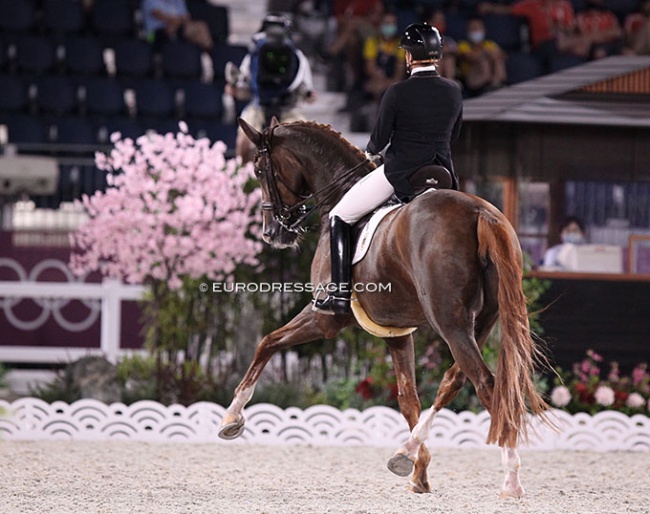
For the first time in three years, since the 2018 World Equestrian Games in Tryon, dressage riders from across globe have met in the competition arena and measured each other out. Grand Prix day at the 2021 Olympic Games in Tokyo concluded at the Baji Koen equestrian centre on Sunday evening 25 July 2021 with dressage sport aficionados taking stock of the world's elite and concluding that Germany, as a team, is on a clear gold medal course.
However, for the individual medals there are several non-German candidates knocking at the door and the Kur to Music Finals, in which the individual medal podium is decided on a clean slate, is promising to be a more than exciting one.
The second day of Grand Prix competition at Baji Koen took place in perfect Tokyo summer weather conditions: clear sky, a sultry 32 C° at the start of the class, but temperatures quickly went down to an appeasing 28 C° as soon as the sun dropped behind the horizon. A nice breeze blew like a cooling fan through the stadium.
Most horses have been coping well with the heat and humidity, but there were a few obviously sweating hard from the exertion and the very long, three-year campaign it took to make it to the Olympics. A few horses could not hide their age, mileage and unusually stretched out build-up to the apex of equestrian sport due to the postponement of the Games by one year.
The Best Move On
The three last heats of 10 riders were ridden on Sunday. With the new Olympic format the Grand Prix serves as a qualification class: the 8 highest scoring teams move on to the team finals (Grand Prix Special), the 2 highest placed riders per heat as well as the 6 highest scoring riders that didn't place first or second in their heat move on to the Individual Finals (Kur to Music).
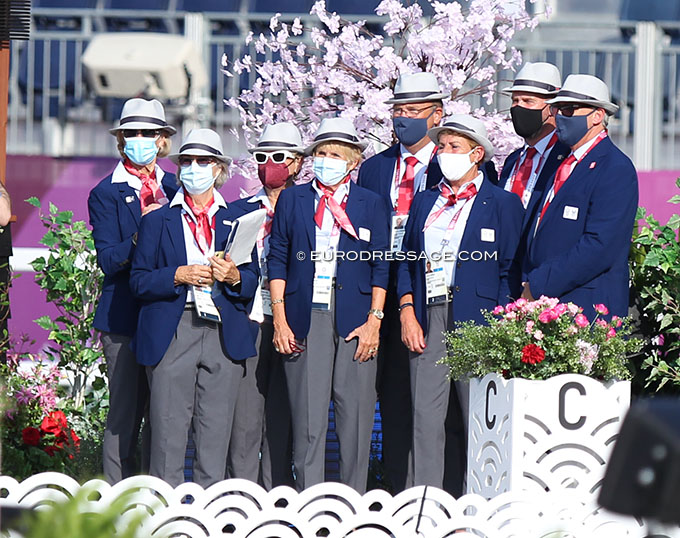
also a career highlight for them
Furthermore, there is criticism that the heat system does not give the opportunity for the best to move onto the Finals, but the detractors are proven wrong as all 18 highest scoring pairs have made it to the Finals and there has been no detriment to a rider who scores higher, but is not eligible to go (as for instance with the system of four per team, but only three can ride the Kur). We say aye to the heat system!
So now let's talk sport.
Germany Makes Its Mark
The German dressage team has been a force of power for decades and it is impressive how they continue to bring to the fore new talented young Grand Prix horses, often ridden by the same riders though.. but that's no different in other countries, where the most experienced riders with the most powerful sponsors behind them have a line of succession ready in the stable.
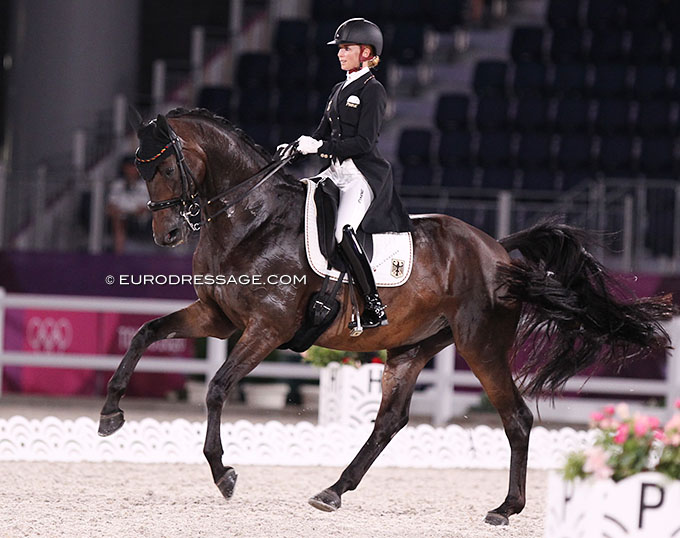
Team Germany qualified for the Special as the highest scoring team in the Grand Prix with Von Bredow's number one score, followed by Isabell Werth placing second on 82.50% and Dorothee Schneider fifth with 78.82%.
Germany's team total was 7911.5 points (the point score of all three GP team riders), Great Britain followed in a distant second place with 7508.5 points, and Denmark was third with 7435.0 points. The USA, which were prognosticated as the silver medal contenders in Tokyo based on the scores the riders achieved this year on home turf in the USA, landed fourth place in the Grand Prix with 7389.5 points.
This team ranking only serves as qualifier for the Special, in which riders start with a clean slate. Joining those four nations for team medals are the Netherlands (7312.0 pts), Sweden (6989.0 pts), Portugal (6862.5 pts) and Spain (6749.5 pts).
Chasing Gold
The last starter on day two was the most decorated dressage rider in history, Isabell Werth. She already won six Olympic gold medals, five of them with the team, but "only" once as an individual rider. That achievement dates back twenty-five years ago to 1996 in Atlanta. In between then and now she was thrice beat by Anky van Grunsven, then for 8 years had no horse for the Games, but returned in Rio 2016 with Weihegold to earn individual silver. The question is now: will she finally get that highly coveted second individual gold medal on 17-year old Westfalian mare Bella Rose (by Belissimo M x Cacir AA)?
Werth is certainly fighting for it and can never be ruled out. An electric show atmosphere brings out the best in her riding and time and again she makes your jaw drop when you see how skilfully she pilots a horse through a programme, while in training she can sometime sit likes a cowboy, elbows almost akimbo, chewing gum, and flexing her horses left to right to keep them supple in the neck.
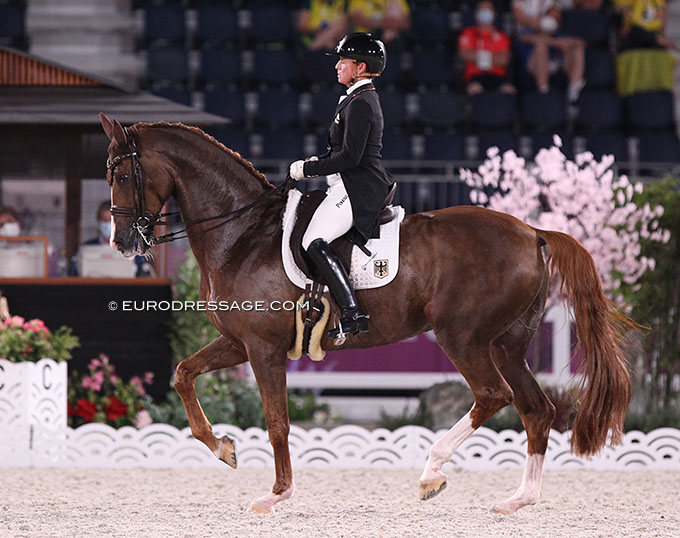
In their first test in Tokyo there were lots of magnificent flashes and some not so great bits. In the Grand Prix the immobility in the halt at entry did not last very long, the half passes were brilliant, especially the one to the left. The piaffe passage had superb rhythm and there was a soft control in the bridle, but the mare sometimes got unsteady in the head. The first two extended trots had just one hoof overstep, were quick in tempo even though the frontleg is scopey (score 7 - 7.5). With the years the mare has lost a lot of quality in her extended walk. There was just one hoof overstep but the rhythm was almost lateral (scores 5 - 7) . The collected walk was just short and sometimes a bit uneven in the stride length of the frontlegs. The second piaffe started two meters before the marker but had great rhythm and good quality as the mare actually tried to climb in front and rise in the withers as it should be. The two tempi changes were correct although from behind it seemed that the ones to the right were shorter. The extended canter was not as great as the mare toppled on the forehand like a rocking horse. The zig zag was stellar, the one tempi changes were correct but could cover more ground. In the pirouettes the mare does not really sit behind and there is little elevation in the forehand, but Werth rides them small and accurately (score 7.5 - 9) . The third trot extension was the best one of the three with the most overtrack. The final centerline was delicious with such great rhythm and flawless transitions in and out of piaffe.
The panel of judges for Tokyo 2020 includes Katrina Wust (GER), Susan Hoevenaars (AUS), Janet Foy (USA), Francis Verbeek (NED), Andrew Gardner (GBR), Hans-Christian Matthiesen (DEN), and Magnus Ringmark (SWE). They rewarded with with 82.500% which made her the winner of Heat 6. The individual marks ranged between 81.522 (Verbeek) and 84.457 (Gardner).
Schneider Close to Peak Performance
Germany's third contributing team score came from Dorothee Schneider who saw her Olympic campaign interrupted this year after she fell of a horse and fractured her clavicle. She rode the German Olympic team selection trials in a special vest with restricted arm mobility. Here in Tokyo you can see that the pair is top class, but have not yet achieved that peak level of performance they showed at the 2019 European Championships in Rotterdam.
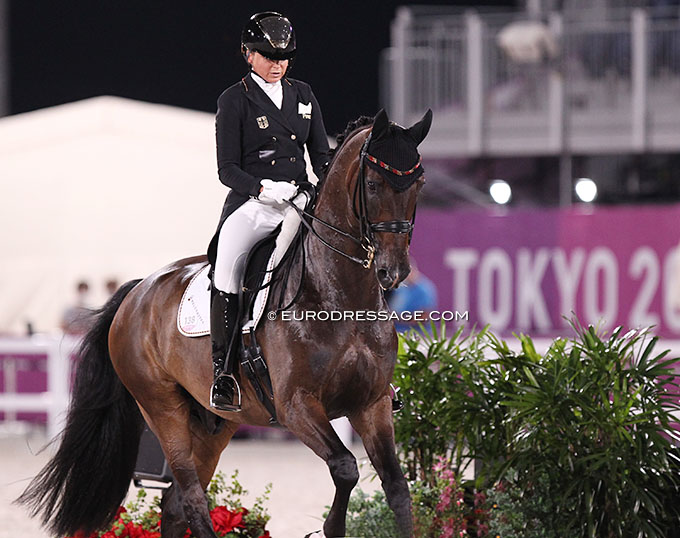
They scored 78.820% to win Heat 5 and place fifth overall in the Grand Prix ranking. The judges' scores ranged from 77.283% (Verbeek) to 79.674% (Ringmark).
Great Britain in the Chase
Team Great Britain has worked its way to a second place in the (non-counting) team ranking after the Grand Prix and promoted itself as serious medal contender.
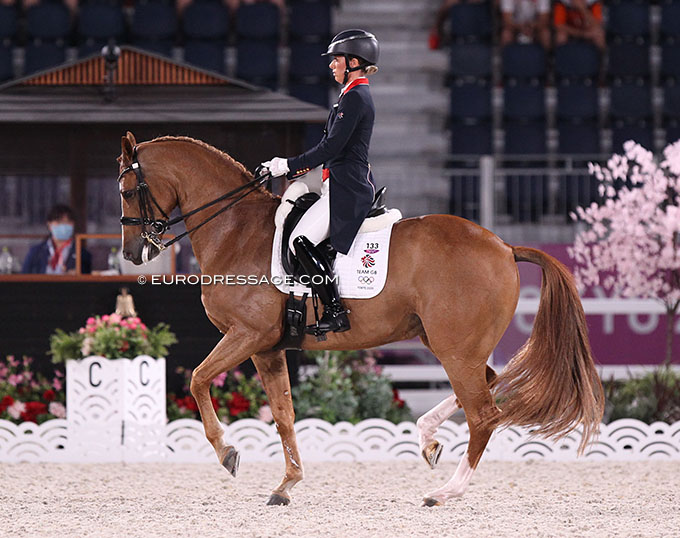
The star of the U.K. was double Olympic champion Charlotte Dujardin who is proving that she is no one-hit wonder on Valegro, but can also produce more horses to top Grand Prix level. She surprised all when she put the younger Gio forward as her team ride and not her WEG team bronze medal winning Mount St. John Freestyle, who has produced higher scores this 2021 show season. Initially the decision was advocated as Dujardin's free choice to take Gio instead of Freestyle. A few days after the official announcement, Freestyle's owner Emma Blundell communicated that the mare is injured.
Riding with the knife between her teeth, Dujardin impressed by presenting a much improved Gio here in Tokyo. The small KWPN bred chestnut (by Apache x Tango) is a little pocket rocket, but has his limitations due to his conformation. He moves very "Dutch" - almost Hackney like - with knees high in an upward instead of forward tendency. While in the months before, Dujardin struggled to get length in the neck and frame, there was improvement in the Grand Prix test in Tokyo, which demonstrates the purpose of dressage: gymnasticizing the horse to full body potential.
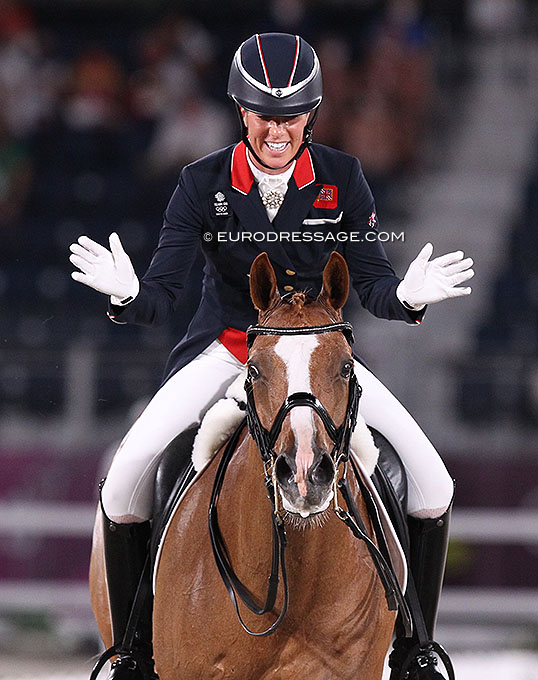
They scored 80.963%, a personal best, and placed second in Heat 6 behind Isabell Werth. Overall they were fourth in the Grand Prix and one of four riders to crack the 80% marker in Tokyo. The individual judges' marks ranged between 79.891% (Hoevenaars) and 82.500% (Verbeek). See video here.
Denmark to Repeat History?
Team Denmark won a historic bronze medal at the 2008 Olympic Games in Hong Kong. The team of Nathalie zu Sayn-Wittgenstein (Digby), Anne van Olst (Clearwater) and Andreas Helgstrand (Blue Hors Don Schufro) wrote history in Asia for their country and it seems like the new Danish equipe of three could be doing something similar in Japan.
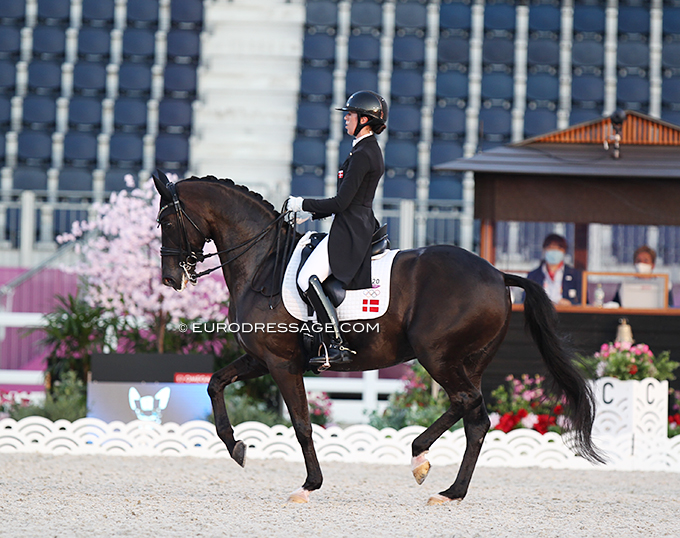
Kruth's gorgeous black mare Heiline's Danciera (by Furstenball x De Niro) is owned by Ingrid and Paul Thøgersen of Four Oaks Farm in Denmark. She was a triple World Young Horse Championships finalist (2016, 2017 and 2018) and was rushed straight to international Grand Prix level in 2019 at age 8. For this horse the postponement of the Olympics by one year was a blessing as she looked overpushed in 2020. The extra year has given her time to develop, muscle up and strengthen in her body. Her mind has not yet caught up as the mare is very stressed in the mouth and has a lower lip that trembles from tension, especially in the piaffe which she finds the most challenging movement at this point in her career. That being said, Danciera is a wonderful mare to watch. She has so much elasticity and spring in his trot and passage and is such an elegant mover, very feminine in her silhouette.
In the Grand Prix Kruth rode the trot work full throttle, flying through the corners. In the left half pass the hindlegs trailed behind. The trot extensions were expansive, the walk extension had plenty of overstep. The collected walk was clear in the rhythm. The passage is bouncy, but in piaffe Danciera leans on the shoulders and creeps forward while crossing behind. The tempi changes were correct, the extended canter uphill although she lost some swing in her back, the zig zag was very well ridden. The left pirouette was big, the right one better.
They scored 76.677% to win Heat 3. The judges were in unison with marks between 76 and 77%.
Team U.S.A. Fourth
Leading up the Olympic Games, score statistician David Stickland made a prognostication of the team ranking based on the CDI scores team riders achieved in 2021. Team USA was firmly predicted to be a silver medal contender. However just like polls in election time prove to be worthless time and again, a prognostications for dressage sport should also be taken with a grain of salt. Not denying Stickland's skill in drafting these, but as all know with horses there can be days that things do not go as planned due to a variety of factors and this will affect the team ranking.
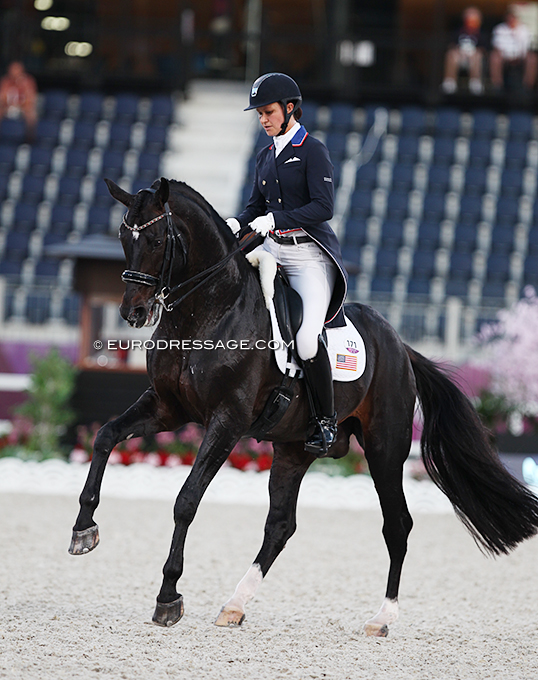
The pressure must have been astronomical for Lyle and although the rider did an exemplary job piloting her handsome stallion through the test, they stayed far from the 80% magic marker. Salvino just didn't present his A-game, unfortunately. The horse was uneven in the rhythm in all three trot extensions, the half pass left had little suspension and there was a mistake in the rhythm. However, the extended walk had sufficient overstep and Salvino relaxed well over the back and the collected walk was very nice. The passage work just did not flow the way it should be; sure he lifts his legs high and the side silhouette is really pretty, but there is no real suspension off the ground and spring on the diagonals. The piaffes are nice but could also have more spring. The two tempi changes were ground covering, but he swayed the hindquarters especially to the right. The ones were good. The extended canter was flat on the forehand with no energetic uphill tendency. The zig zag looked laboured, the left pirouette was big, the right one was much better although the exit out was big too. The third trot extension was probably the best one. Salvino certainly had a lot of shoulder freedom, but he did not flow through his body in that test. It's a pity and hopefully he'll recover for the team competition in the Special.
It was obvious that the judges were puzzled what to do with this test below par. The overall score was 74.876% that placed them second in Heat 4 and 14th overall in the ranking; but the judges were all over the place with their individual marks. The low score was a more realist 71.957% (Verbeek) while the high score was 78.370% (Hoevenaars).
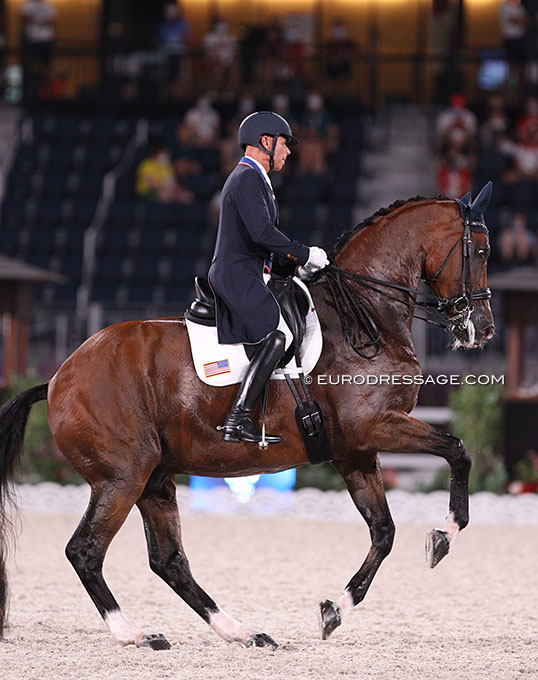
In Tokyo Peters rode the best test on Suppenkasper we have ever seen him ride. The trot extensions were uphill, the half passes sweeping. The halt before the rein back was beautiful. In the second extension there was a loss of rhythm. Suppenkasper has a super engaged hind leg in the passage and is almost over-achiever, reaching so far under the body that he not always can sustain this power and takes a few uneven steps. The first piaffe was a bit on the shoulder. The collected walk was clear in the rhythm. Suppenkasper's piaffe is nice from the side view but in front or behind, you see he's not truly carrying himself and goes wide in front. He also tends to do this in passage and sway much in his body, but in the Tokyo Grand Prix his balance was much better. The zig zag was well ridden, the two tempi changes correct, the ones could have been straighter. The left pirouette was gorgeous, the right one a bit unbalanced. The final passage before the halt got a bit crooked to the right.
The pair scored 76.196% for this ride, a score which he usually gets, but this time it was well earned without halo points. The individual judges' marks went from 75.217 (Verbeek) to 77.283% (Hoevenaars). They were third in Heat 6, but qualified for the Freestyle as one of the 6th highest scoring riders that did not finish in the first two places of his heat.
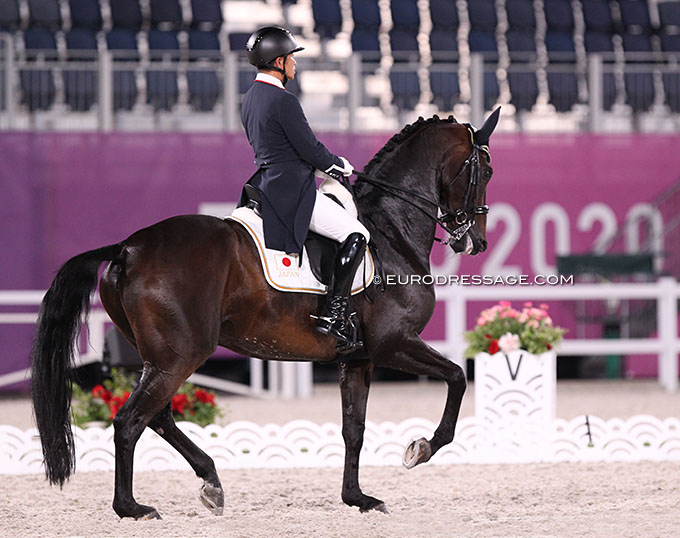
here at Baji Koen equestrian centre and now proudly
represented his country at the Olympics
Text and Photos © Astrid Appels - No Reproduction Allowed!!
Related Link
Eurodressage Coverage of the 2021 Olympic Games